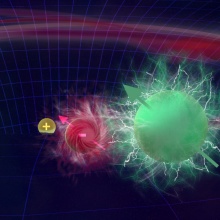When collisions between atomic-scale objects happen at very low energies, their outcomes are determined by the laws of quantum mechanics and feature properties absent in the classical world. An experimental team at the University of Stuttgart led by Florian Meinert has now devised the world’s smallest particle collider to measure detailed aspects of the quantum scattering between a single electron and a neutral atom. This collider was formed by an atom whose outermost electron is inflated to a giant Rydberg state and frequently scatters with laser-cooled ground state atoms residing inside its orbital.
In this way, the team managed to probe ultralow-energy electron-neutral collisions with a precision previously inaccessible by other means. In the quantum world, collision properties are intimately linked to weakly bound states the two scattering partners form for a short instance of time during their encounter, which here is an electron transiently bound to an atom – a negative ion. This elusive object only lives for a few pico-seconds, but the fact that the Rydberg electron is bound to the atom core enforces its frequent return and by that allowed the team to probe previously unobserved details of the negative-ion state in collaboration with theory colleagues from Hamburg. In the future, the demonstrated atomic-scale collision laboratory may allow to probe even more complex objects such as molecules or clusters.


